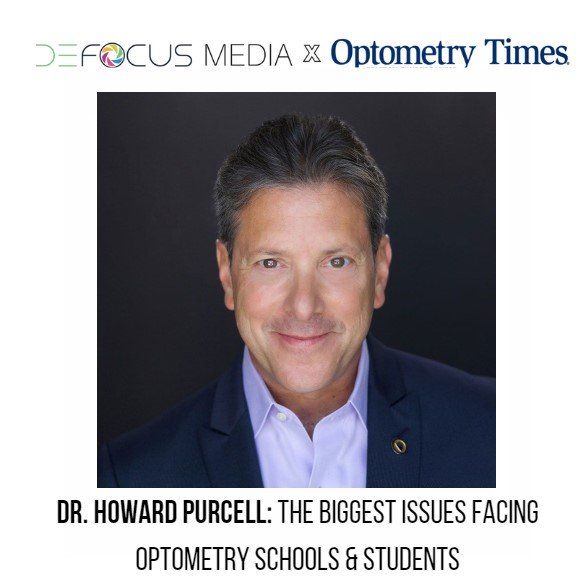Biggest challenges facing optometry schools and students

Howard Purcell, OD, FAAO, president and CEO of New England College of Optometry, looks at challenges facing optometry students and optometric education. In addition, he invites the entire optometric community to participate in The Industry Collaborative, a group of industry partners who want to brainstorm solutions.
In today’s climate, it is hard to argue that the biggest issue facing optometry schools, students, practicing doctors, and humanity is the novel coronavirus and COVID-19 pandemic. But even before this worldwide event changed everyday life, optometry was facing serious challenges.
Howard Purcell, OD, FAAO, president and CEO of the New England College of Optometry, brings his background and relationships with industry partners together to help tackle these challenges head-on with a project called the Industry Collaborative. He shares the biggest concerns that students and schools across the country face and what optometry as a profession can do about it.
Related: What the COVID-19 relief package means for ODs
The Industry Collaborative
The Industry Collaborative includes participants from 44 industry partners, including Essilor, Johnson & Johnson Vision, and Jobson. Together at the SECO 2020 meeting in March, they signed a “Proclamation” agreement committing to collaborating and providing time and resources toward achieving three key objectives in improving the long-term health of optometry as a profession:
• Practice empowerment and acceleration
• Public perception and expectation of optometry
• Impact of technology on optometry and optometry on technology
Related: Telemedicine in the face of COVID-19
These objectives were identified by the members of the collaborative as the biggest threats to optometry students, schools, and the future of practicing optometrists and identified as the three highest priority objectives from a larger list of 10 challenges identified at a meeting in early November 2019:
1. Improving business acumen
2. Impact of technology
3. Private equity
4. Expanding and practicing full-scope optometry
5. Healthcare reform and third-party reimbursements
6. Embracing medical services
7. Increasing interest in optometry as a profession
8. Reducing debt and the cost of education
9. Improving access to care in rural communities
10. Bias about practice modalities
Related: How doctors should handle crisis communication during COVID-19
Optometric education challenges
“We have challenges in optometric education, there’s no doubt,” Dr. Purcell says.
Exposing students to disruptive technology, telehealth, and various employment options while still in school has been a change in mindset that he has focused on at his time at New England College of Optometry.
Related: COVID-19 means I’m a full-time, stay-at-work mom
“We focus on preparing today’s optometrists for tomorrow’s optometry,” he says.
One of the criticisms Dr. Purcell often hears about optometry schools is that students are unprepared for the business aspects of optometry. He agrees that this is a critical subject, but given the current format of optometric education’s 4-year program the time students spend on and off campus necessarily emphasizes clinical knowledge and experience.
A proposed solution from the Industry Collaborative is working with industry partners to help create an optional business education series in the summer following fourth-year graduation for interested doctors.
Related: How I have been using telemedicine amid COVID-19
Another major concern optometry colleges are facing is a low applicant pool and a lack of diversity among students.
“We continue to struggle to interest people of color to become optometrists,” Dr. Purcell says.
In 2016, ASCO published statistics showing only 2.7 percent of enrolled optometry students identified as black or African American, and only 5.5 percent reported as Hispanic or Latino.1 One of the major concerns Dr. Purcell says that schools face is that because optometry schools don’t have many African American or Latino students, potential students interviewing or touring campuses can’t picture themselves there because they don’t see anyone who looks like them.
Related: Why I wear scrubs in the office during COVID-19
“Our patients tend to look like us,” Dr. Purcell says. “We are not servicing the community that is underserved. We have to do a better job.”
Student debt continues to be a major hurdle for students across the country, including optometry students. In 2019, optometry school graduates reported an average student debt of $173,000.2 In addition to minimizing increases in tuition costs, one way to address this concern is focusing on increasing the number of scholarships available to students. Dr. Purcell envisions involving employers and industry partners to create and fund scholarships to help students minimize debt.
Related: Fashion advice from an OD on the frontlines of COVID-19
The path forward is not easy, and each of the 10 challenges that the Industry Collaborative has outlined is complex and in some cases polarizing. Involving more voices involved, devoting more brain power to creative thinking, and dedicating more time and resources to implementing solutions is the goal of this initiative.
“We want everyone who would like to participate to be able to do so,” Dr. Purcell says.
If you would like to get involved, email Dr. Purcell at purcellh@neco.edu.
More by Dr. Lyerly: Refractive surgery in 2020: From minimally invasive LASIK to light adjustable lenses
References:
1. Gary Y. Chu, OD, MPH (Guest Editor), Lillian Kalaczinski, OD, Diane Russo, OD, MPH, Janet Leasher, OD, MPH, Keisha Elder, OD, and Barbara Fink, OD, PhD. Diversity in our Colleges and Schools of Optometry. Optom Edu. Available at: https://journal.opted.org/article/diversity-in-our-colleges-and-schools-of-optometry/. Accessed 5/6/20.
2. Geller M. The Optometry Student Loan Repayment Calculator. Covalent Careers. Available at: https://covalentcareers.com/resources/optometry-student-debt-calculator/. Accessed 5/6/20.
Newsletter
Want more insights like this? Subscribe to Optometry Times and get clinical pearls and practice tips delivered straight to your inbox.